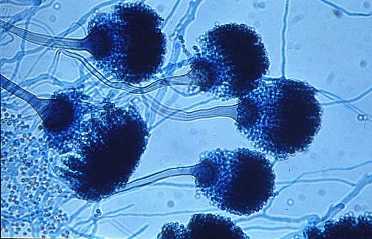Molds, Mycotoxins, & More

There are so many possible sources of these toxic compounds found in WDB that can lead to the variety of symptoms caused by mold illness, no single compound can be identified as the sole cause of the inflammatory responses, or the illness, seen in affected patients. Since no one thing can be deemed as solely responsible for the sickness, the sole cause becomes the WDB itself.
Below is a list of of some of these dangerous compounds and an explanation of each. Please understand this toxic chemical stew is a very complex mixture that truly wreaks havoc in the body. These explanations are simplified to make them easier to understand.
Knowledge is power and patients have the right to understand what is making them sick, so they can avoid exposure in the future.
- Fungi (fun�ji) - A single-celled or multicellular organism. Fungi can be true pathogens that cause infections in healthy persons or they can be opportunistic pathogens that cause infections in immunocompromised persons.
- Bacteria (bak-tēr�e-ah) - Single-celled microorganisms which can exist either as independent (free-living) organisms or as parasites (dependent upon another organism for life).
- Actinomycetes - A group of gram-positive bacteria (order Actinomycetales) that produce various bioactive agents.
- Mycobacteria [mī′kōbaktir′ē�ə] - A large family of bacteria that have unusually waxy cell walls that are resistant to digestion.
-
Mold (mōld) - Mold refers to multiple types of fungi that grow in filaments and reproduce by forming spores. Mold may grow indoors or outdoors and thrives in damp, warm, and humid environments. Mold can be found in essentially any environment or season.
The most common types of mold that are found indoors include Cladosporium, Penicillium, Alternaria, and Aspergillus. Stachybotrys chartarum (also known as Stachybotrys atra and sometimes referred to as "black mold") is a greenish-black mold that can also be found indoors. Stachybotrys grows on household surfaces that have high cellulose content, such as wood, fiberboard, gypsum board, paper, dust, and lint.
Molds reproduce by forming tiny spores that not visible to the naked eye. Mold spores are very hardy and can survive under conditions in which mold cannot grow, such as in dry and harsh environments. These spores travel through outdoor and indoor air. When mold spores land on a surface where moisture is present, mold can start to grow.
-
Spore (spor) - tiny spores that are not visible to the naked eye produced by mold. Mold spores are very hardy and can survive under conditions in which mold cannot grow, such as in dry and harsh environments. These spores travel through outdoor and indoor air. When mold spores land on a surface where moisture is present, mold can start to grow.
-
Mycotoxins (mī′kōtok′sin) - toxic chemicals that are present on spores and small fragments of mold and fungus that are released into the air.
-
Endotoxins (en′dōtok′sin) - also called Lipopolysaccharides (LPS), are cell wall components of Gram negative bacteria. They are shed into the environment of WDB upon death of the bacteria. LPS cause inflammatory responses via signaling pathways in the body, releasing inflammatory cytokines. LPS aggravate existing lung disease (asthma, HP), can cause inflammation of the lungs and are synergistic with mycotoxins.
-
Inflammagens (in-flam�ah-jen) - an irritant that elicits both edema and the cellular response of inflammation
-
Beta Glucans (beta-glucans) - are polysaccharides of D-glucose monomers linked by β-glycosidic bonds. β-glucans are a diverse group of molecules that can vary with respect to molecular mass, solubility, viscosity, and three-dimensional configuration.
-
Hemolysins - exotoxins produced by bacteria that cause lysis of red blood cells in vitro.
-
Microbial Volatile Organic Compounds (VOCs) - Microbes can release organic compounds into the air when there is adequate food supply for such “secondary metabolite” production. These volatile compounds, called mVOCs for short, can give basements their distinctive musty odor as well as activate innate immune responses in susceptible patients. While we think of fungi as the most common producers of mVOCs, bacteria and actinomycetes are indoor-producers as well.